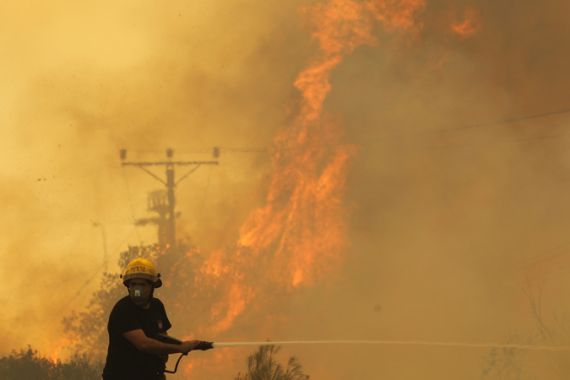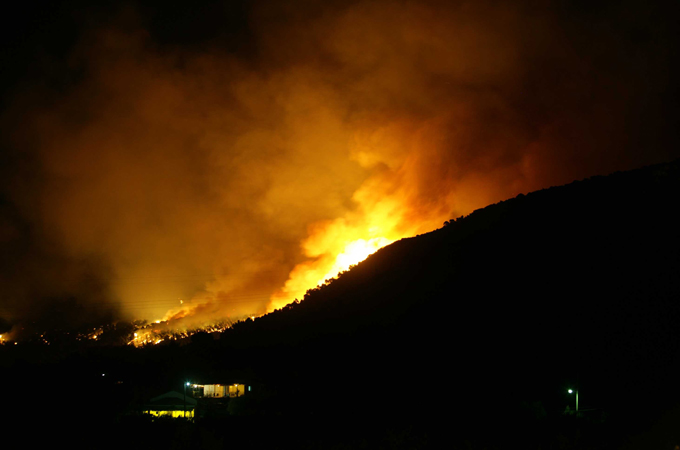Climate change link to forest fires
A new report identifies global warming as a driver of forest fires in northern latitudes.

 |
| Forest fires are set to become more intense, and more harmful to the environment, a new study reports [Getty] |
Global warming is causing forest fires in northern latitudes to burn more frequently and fiercely, contributing to the threat of runaway climate change, according to a new environmental study.
The report published in Nature Geoscience, found that the increased intensity of fires in Alaska’s vast interior over the last decade has changed the region from a sink to a source of carbon dioxide, the greenhouse gas most responsible for heating up the planet, the study found.
Keep reading
list of 4 itemsLost Futures
Photos: Greek valley that became a lake stirs drought debate
Botswana threatens to send 20,000 elephants to Germany
In other words, boreal forests in the northern hemisphere may now soak up less of the heat-trapping gas than they give off.
The bulk of the released CO2 comes not from the burning trees, but from what is in the ground.
“Most of what fuels a boreal fire is plant litter, moss and organic matter in surface soils,” Merritt Turetsky, a professor at the University of Guelph in Ontario and lead author of the study, said.
Turetsky said that the findings were worrying because about half of the world’s soil carbon was trapped in northern permafrost and peatlands.
“This is carbon that has accumulated in ecosystems a little bit at a time for thousands of years, but is being released very rapidly.”
Climate conference
The study came out as ministers from nearly 200 countries gathered in Cancun, Mexico in an attempt to hammer out an agreement on how to keep global warming in check.
The UN forum could announce measures to slow tropical deforestation, which both releases CO2 and shrinks the biomass that soaks it up.
The destruction of equatorial forests in Latin America, Asia and Africa accounts for 12 to 15 per cent of the carbon pollution released into the atmosphere each year, according to recent calculations.
Boreal forests, however, have received scant attention at the talks.
While the study focused on Alaska’s 185,000 square kilometres, of forests, its conclusions likely apply to huge expanses of wilderness in Siberia, Canada and northern Europe as well.
Out-of-control fires ravaged more than 10,000 square kilometres in Russia earlier this year, destroying whole villages and leaving more than 50 people dead.
The shift of subarctic forests and peatlands from a CO2-absorbing sponge to a net source of the gas means that these regions could help trigger accelerated global warming, the study warned.
“Essentially, it represents a runaway climate change scenario in which warming is leading to larger and more intense fires, releasing more greenhouse gases and resulting in more warming,” Turestsky said.
The same vicious-circle effect – what scientists call “positive feedback” – is true of the shrinking Arctic ice cap, which has likewise become both symptom and cause of climate change.
As ice cover recedes decade-by-decade, more of the Sun’s radiative force is absorbed by dark-blue ocean water rather than bounced back into space by reflective ice and snow.
Temperatures rising
The Arctic and subarctic regions have been hit particularly hard by global warming, with temperatures rising two to three times faster than the global average.
In the study, Turetsky and colleagues examined nearly 200 forest and peatland sites in Alaska shortly after blazes were extinguished to measure how much biomass had burnt.
The amount of scorched earth has doubled in interior Alaska over the last 10 years, mostly because of increased burning late in the fire season, they found.
“We have demonstrated for the first time that increases in burned area are clearly linked to increases in fire severity,” Eric Kasische, a professor at the University of Maryland and co-author of the study, said.
“This not only impacts carbon storage, but also will accelerate permafrost loss and changes in forest cover.”
Ten of billions of tonnes of another potent greenhouse gas, methane, are also trapped inside permafrost.